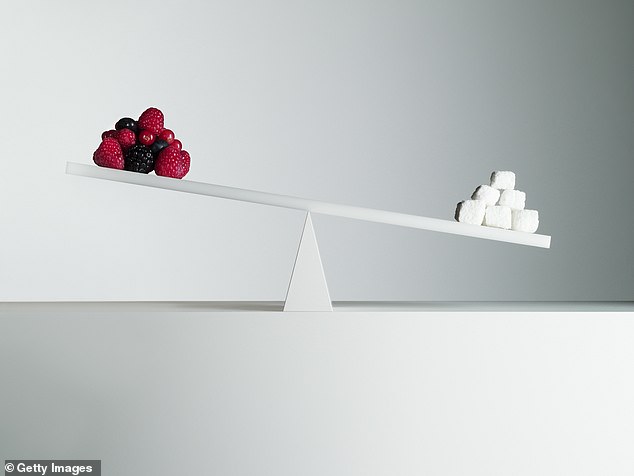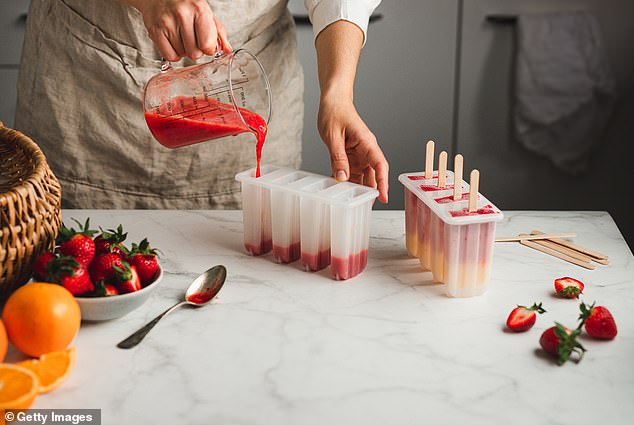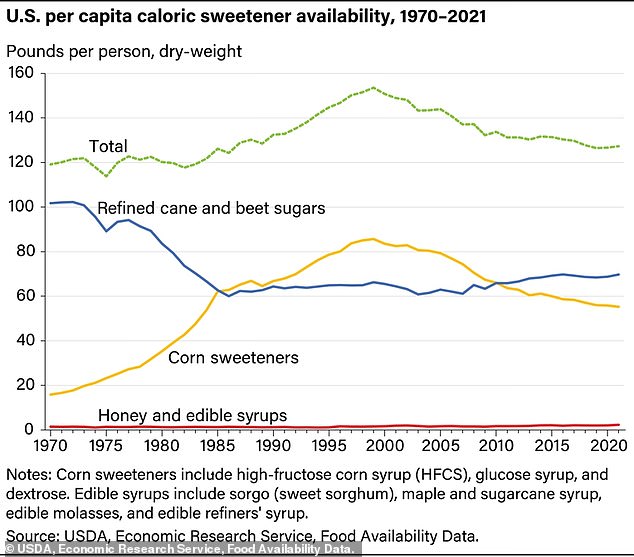The Nutrition Twins reveal the only sweetener that’s good for you – and how to beat sugar cravings FOR LIFE
Of all the questions customers ask us, the most frequently asked question is, “How can I stop craving sweet treats?”
They’re lazing on the couch after dinner, or bored at their desk in the office, and they can’t resist reaching for candy or chocolate.
As tasty as it is, sugar, as we know, is not a nutrient we should eat in abundance.
The nutrition twins helped themselves kick their frozen yogurt habit by making homemade popsicles with fruit and small amounts of natural sweeteners, like monk fruit.

Natural sugars, such as stevia, allulose and monk fruit, are better alternatives to artificial sugars. We also recommend swapping pastries and sweets for fruit.
Americans, on average, eat two to three times more sugar than medical authorities recommend, according to the American Heart Association. A diet high in sweet things has been linked to heart disease, diabetes and obesity.
Experts believe that some of the current rise in early-onset cancers may be due in part to our country’s sweet tooth, and the fact that it is easy to mindlessly consume hundreds of extra calories in the form of cakes and cookies.
Some experts will say that resisting the urge to snack on sweets is simply a matter of willpower; you need to train your taste buds away from sugar.
But they are wrong. You can – and should – still enjoy the taste of sweet foods. But there are much healthier ways to do this than reaching for that candy bar. Below we explain three ways to prevent your desires from controlling you.
This includes tweaking your meals to keep you satisfied, and finding alternatives to sugar – including a natural sweetener that’s actually good for you…
USE SMART SWAPS… AND ONE TYPE OF SWEETENERS

By making your own popsicles with real fruit and minimal added sugar, you can satisfy your sweet tooth and cut back on the sugar.
The first thing to say is: don’t blame yourself for your sweet tooth. Over the years, food manufacturers have hijacked our taste buds by packing the food we buy with extra sugar to keep us going back for more.
The brain and stomach adapt and begin to crave excess sweets, making naturally sweet things less satisfying.
That’s why we are realistic with our customers, because we understand that a diet without sugar is not impossible at all, but miserable for some.
Instead, we suggest some smart swaps that will reduce the amount of sugar in your diet without you really noticing.
This might mean making coffee at home instead of going to Starbucks, and using homemade salad dressing instead of prepackaged bottles, which contain sugar.
It may also be worth freezing your own popsicles with fresh fruit, which gives you a natural sugar fix without the excess added by the manufacturers.
When it comes to artificial sweeteners, there’s none we recommend because research shows that the taste can increase sugar cravings, while the chemicals attack the healthy bacteria in your gut.
However, natural sweeteners like stevia have been shown to cause minimal disruption to your microbiome. In fact, some studies have found that stevia can promote the growth of beneficial bacteria, with knock-on effects on immune health.
HACK YOUR MEALS TO FIGHT CRAVINGS

The total amount of sugar supplied to food and drink manufacturers is approaching 1970s levels. Yet millions of Americans still consume about 300 percent of the recommended amount of sugar
Sugar cravings may have to do with the quality of your diet.
We often find that clients who like sweet things have low energy because they are not eating enough, or because they are eating unfulfilling foods that do not stabilize their blood sugar levels.
Sugar is the fastest and cheapest way to get an energy boost. It raises blood sugar levels quickly, giving you a temporary boost. But it’s transient and can cause an energy crash, leaving you craving more sugar for a quick lift.
But by eating well-rounded meals with the right portion sizes, you may find that you have less need for snacks between meals.
We recommend including plenty of produce, plenty of protein, small amounts of healthy carbohydrates and healthy fat at each meal to help you stay full longer and avoid cravings.
For breakfast, try an omelet, made with vegetables and extra egg white, for extra filling protein.
Add a slice of whole wheat bread for a dose of gut-boosting fiber.
These types of meals keep you full for much longer than a bagel with cream cheese, for about a quarter of the calories.
Add an extra boiled egg or serving of whole-grain rice to your lunch for a filling boost without a ton of excess calories.
For dinner, try throwing a protein source, like salmon, on a baking sheet with vegetables. Roast the whole thing so that it is ready in one go.
The longer you feel full, the less likely you are to reach for more sugar after a meal.
FILLING YOUR INTESTINAL TUBES WILL DEFEAT TEMPTATION

Manufacturers often add more sugars than you might think for taste and shelf life.
If correcting blood sugar levels doesn’t work, we look at gut health.
Some studies have shown that too much sugar can promote the growth of unhealthy bacteria in the gut – the type that causes this the cells in our gastrointestinal tract become inflamed.
Chronic inflammation has been linked by researchers at the National Institute of Health to premature aging, dementia, diabetes, depression and cancer.
Worse still, the more this bacteria grows, the more you crave sugar, research shows.
There is some early research suggesting that the bad bacteria that thrive on sugary diets may be linked to colorectal cancers.
So how do you solve this vicious cycle? One method is to increase your intake of prebiotic rich foods that nourish good bacteria and eradicate the bad.
This includes foods such as asparagus, garlic, onions, apples, barley and oats.
All in all, a little sugar is okay.
The American Heart Association allows men a maximum of nine teaspoons of added sugar per day, and women six teaspoons per day.
For reference, you get about 10 teaspoons of sugar in a can of Coke.
Common sense also plays a role, make sure you pay attention to your food as you eat it. You’re much less likely to consume too much sugar if, for example, you don’t mindlessly chew it while watching TV.
If you eat moderate amounts of sugar in addition to a balanced diet, you don’t have to feel guilty about it.
Visit to learn more about us NutritionTwins.com.
